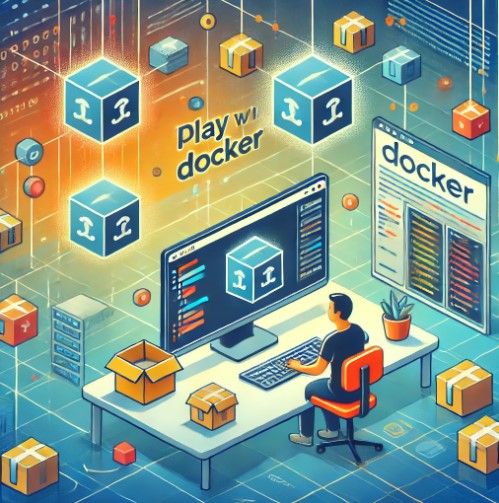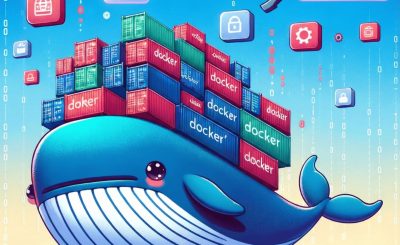Table of Contents
Introduction
In today’s rapidly evolving tech landscape, Docker has become a cornerstone for software development and deployment. Its ability to package applications into lightweight, portable containers that run seamlessly across any environment makes it indispensable for modern DevOps practices.
However, for those new to Docker, the initial setup and learning curve can be intimidating. Enter Play with Docker (PWD), a browser-based learning environment that eliminates the need for local installations, offering a sandbox for users to learn, experiment, and test Docker in real time.
In this guide, we’ll walk you through Play with Docker, starting from the basics and gradually exploring advanced topics such as Docker networking, volumes, Docker Compose, and Docker Swarm. By the end of this post, you’ll have the skills necessary to leverage Docker effectively-whether you’re a beginner or an experienced developer looking to polish your containerization skills.
What is Play with Docker?
Play with Docker (PWD) is an online sandbox that lets you interact with Docker right from your web browser-no installations needed. It provides a multi-node environment where you can simulate real-world Docker setups, test new features, and experiment with containerization.
PWD is perfect for:
- Learning and experimenting with Docker commands.
- Creating multi-node Docker environments for testing.
- Exploring advanced features like networking and volumes.
- Learning Docker Compose and Swarm orchestration.
Why Use Play with Docker?
1. No Installation Hassle
With PWD, you don’t need to install Docker locally. Just log in, start an instance, and you’re ready to experiment with containers in a matter of seconds.
2. Safe Learning Environment
Want to try out a risky command or explore advanced Docker features without messing up your local environment? PWD is perfect for that. You can safely experiment and reset if necessary.
3. Multi-node Simulation
Play with Docker enables you to create up to five nodes, allowing you to simulate real-world Docker setups such as Docker Swarm clusters.
4. Access Advanced Docker Features
PWD supports Docker’s advanced features, like container networking, volumes for persistent storage, Docker Compose for multi-container apps, and Swarm for scaling applications across multiple nodes.
Getting Started with Play with Docker
Step 1: Access Play with Docker
Start by visiting Play with Docker. You’ll need to log in using your Docker Hub credentials. Once logged in, you can create a new instance.
Step 2: Launching Your First Instance
Click Start to create a new instance. This will open a terminal window in your browser where you can run Docker commands.
Step 3: Running Your First Docker Command
Once you’re in, run the following command to verify Docker is working properly:
docker run hello-worldThis command pulls and runs the hello-world image from Docker Hub. If successful, you’ll see a confirmation message from Docker.
Basic Docker Commands
1. Pulling Images
Docker images are templates used to create containers. To pull an image from Docker Hub:
docker pull nginxThis command downloads the Nginx image, which can then be used to create a container.
2. Running a Container
After pulling an image, you can create a container from it:
docker run -d -p 8080:80 nginxThis runs an Nginx web server in detached mode (-d) and maps port 80 inside the container to port 8080 on your instance.
3. Listing Containers
To view running containers, use:
docker psThis will display all active containers and their statuses.
4. Stopping and Removing Containers
To stop a container:
docker stop <container_id>To remove a container:
docker rm <container_id>Intermediate Docker Features
Docker Networking
Docker networks allow containers to communicate with each other or with external systems.
Creating a Custom Network
You can create a custom network with:
docker network create my_networkConnecting Containers to a Network
To connect containers to the same network for communication:
docker run -d --network my_network --name web nginx
docker run -d --network my_network --name db mysqlThis connects both the Nginx and MySQL containers to my_network, enabling them to communicate.
Advanced Docker Techniques
Docker Volumes: Persisting Data
By default, Docker containers are stateless—once stopped, all data is lost. To persist data, Docker uses volumes.
Creating a Volume
To create a volume:
docker volume create my_volumeMounting a Volume
You can mount the volume to a container like this:
docker run -d -v my_volume:/data nginxThis mounts my_volume to the /data directory inside the container, ensuring data is not lost when the container is stopped.
Docker Compose: Simplifying Multi-Container Applications
Docker Compose allows you to manage multi-container applications using a simple YAML file. This is perfect for defining services like web servers, databases, and caches in a single configuration file.
Example Docker Compose File
version: '3'
services:
web:
image: nginx
ports:
- "8080:80"
db:
image: mysql
environment:
MYSQL_ROOT_PASSWORD: passwordTo start the services defined in this file:
docker-compose upDocker Compose will pull the necessary images, create containers, and link them together.
Docker Swarm: Orchestrating Containers
Docker Swarm allows you to deploy, manage, and scale containers across multiple Docker nodes. It turns multiple Docker hosts into a single, virtual Docker engine.
Initializing Docker Swarm
To turn your current node into a Swarm manager:
docker swarm initAdding Nodes to the Swarm
In Play with Docker, you can create additional instances (nodes) and join them to the Swarm using the token provided after running swarm init.
Frequently Asked Questions
1. How long does a session last on Play with Docker?
Each session lasts about four hours, after which your instances will expire. You can start a new session immediately after.
2. Is Play with Docker free to use?
Yes, Play with Docker is completely free.
3. Can I simulate Docker Swarm in Play with Docker?
Yes, Play with Docker supports multi-node environments, making it perfect for simulating Docker Swarm clusters.
4. Do I need to install anything to use Play with Docker?
No, you can run Docker commands directly in your web browser without installing any additional software.
5. Can I save my work in Play with Docker?
Since Play with Docker is a sandbox environment, your work is not saved between sessions. You can use Docker Hub or external repositories to store your data.

Conclusion
Play with Docker is a powerful tool that allows both beginners and advanced users to learn, experiment, and master Docker-all from the convenience of a browser. Whether you’re just starting or want to explore advanced features like networking, volumes, Docker Compose, or Swarm orchestration, Play with Docker provides the perfect environment.
Start learning Docker today with Play with Docker and unlock the full potential of containerization for your projects! Thank you for reading the DevopsRoles page!
